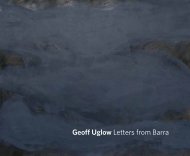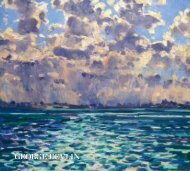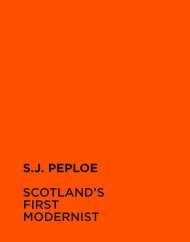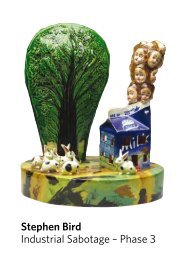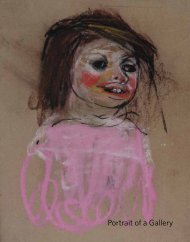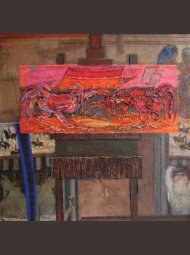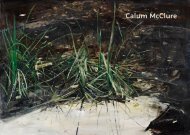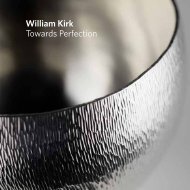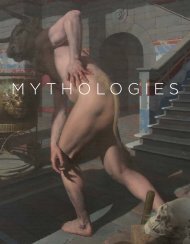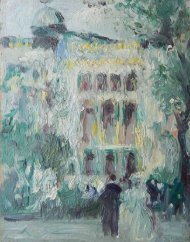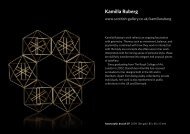Download a PDF of the exhibition catalogue - The Scottish Gallery
Download a PDF of the exhibition catalogue - The Scottish Gallery
Download a PDF of the exhibition catalogue - The Scottish Gallery
You also want an ePaper? Increase the reach of your titles
YUMPU automatically turns print PDFs into web optimized ePapers that Google loves.
JOAN EARDLEY<br />
edinburgh<br />
london<br />
3 – 27 April 2013 1 – 17 MAY 2013<br />
16 Dundas Street, Edinburgh EH3 6HZ<br />
Tel 0131 558 1200 Email mail@scottish-gallery.co.uk<br />
www.scottish-gallery.co.uk<br />
8 Bennet Street, London SW1A 1RP<br />
Tel 020 7493 1888 Email art@portlandgallery.com<br />
www.portlandgallery.com<br />
Cover: Children and Chalked Wall, c.1962 (detail), mixed media on paper, 36 x 56 cms<br />
Left: Flowers by <strong>the</strong> Wayside, c.1961 (detail), oil on canvas, 61 x 56 cms
Foreword<br />
50 years have now passed since <strong>the</strong> death <strong>of</strong> Joan Eardley in August 1963.<br />
In one important sense her light, that burned so brightly, is still bright<br />
today; her work seems as urgent, honest and enthralling as when it was<br />
made. She would have been little concerned with her artistic legacy being a<br />
person entirely caught up with <strong>the</strong> drama and tribulation <strong>of</strong> <strong>the</strong> process <strong>of</strong><br />
making art. It was <strong>the</strong> process that truly mattered; sometimes her drawings<br />
were given to <strong>the</strong> children who thronged through her Townhead studio, to<br />
be later used to light a fire in <strong>the</strong> paternal hearth, or discarded paintings<br />
on board used to lag <strong>the</strong> l<strong>of</strong>t space <strong>of</strong> her Catterline cottage. But she was a<br />
passionate, driven painter who worked tirelessly, no doubt to <strong>the</strong> cost <strong>of</strong> her<br />
health; <strong>the</strong> next picture was <strong>the</strong> only one that mattered. <strong>The</strong>se character<br />
traits were not at <strong>the</strong> cost <strong>of</strong> humanity; indeed her work could not have<br />
been made without a deep sympathy for her subject and <strong>the</strong> wider human<br />
condition. Family, friends, collectors and pr<strong>of</strong>essionals within <strong>the</strong> art world<br />
would have helped keep her flame alive and ensure that many more can<br />
discover her genius.<br />
This <strong>exhibition</strong>, which complements a new publication by Christopher<br />
Andreae, celebrates Joan Eardley. <strong>The</strong>re are works from Townhead to<br />
Catterline and from studies abroad in France and Italy.<br />
We are delighted to have London’s Portland <strong>Gallery</strong> as our partner in this<br />
<strong>exhibition</strong>. For <strong>the</strong> last thirty years <strong>The</strong> Portland has championed <strong>the</strong> work<br />
<strong>of</strong> 20th century and contemporary <strong>Scottish</strong> artists so is <strong>the</strong> natural venue<br />
for <strong>the</strong> London showing <strong>of</strong> this <strong>exhibition</strong>.<br />
Both <strong>The</strong> <strong>Scottish</strong> <strong>Gallery</strong> and Portland <strong>Gallery</strong> would particularly like<br />
to thank Christopher Andreae, Joan Eardley’s family and James Morrison.<br />
GUY PEPLOE<br />
Director, <strong>The</strong> <strong>Scottish</strong> <strong>Gallery</strong><br />
Joan Eardley painting in Catterline. Photograph by Audrey Walker<br />
3
Shipbuilder’s Street, c.1951<br />
oil on canvas, 94 x 34.25 cms
Introduction<br />
Joan Eardley’s association with <strong>The</strong> <strong>Scottish</strong> <strong>Gallery</strong> began as long ago<br />
as 1955. <strong>The</strong> <strong>Gallery</strong> since <strong>the</strong>n has exhibited her work in a procession<br />
<strong>of</strong> shows both during her lifetime and after, with only one pause <strong>of</strong> any<br />
duration – between 1996 and 2007. And now, fifty years after she died,<br />
this <strong>Gallery</strong>, in association with London’s Portland <strong>Gallery</strong>, has once<br />
again brought toge<strong>the</strong>r a wonderful, representative selection <strong>of</strong> her work<br />
from private collections. All <strong>the</strong>se works are for sale. This is no small<br />
achievement because many private Eardley owners display a firmly held<br />
reluctance, despite rising sales figures, to consider parting with <strong>the</strong>ir<br />
Eardleys.<br />
Her appeal persists. She can no longer be justifiably described as<br />
just a remarkable painter <strong>of</strong> her time (<strong>the</strong> late forties, <strong>the</strong> fifties and <strong>the</strong><br />
early sixties). She is, lastingly, an irresistible, fresh and original artist by<br />
any standard, without any call for such qualifiers (even if <strong>the</strong>y are not<br />
intentionally demeaning) as ‘<strong>Scottish</strong>’, ‘twentieth century’ and ‘woman<br />
artist’.<br />
This <strong>exhibition</strong> ranges across <strong>the</strong> wide scope <strong>of</strong> subject-matter in<br />
Eardley’s work – and it is significant that she never abandoned <strong>the</strong> necessity<br />
<strong>of</strong> ‘<strong>the</strong> subject’. She felt strongly that it was truth to her subjects that would<br />
ensure that her style <strong>of</strong> painting and drawing was entirely her own, a very<br />
direct encounter or entanglement with individual slum children, with<br />
pr<strong>of</strong>oundly sleeping babies, summer fields deep in wild grasses and flowers,<br />
with dangerously surging, rock-crashing waves, weighty, dark-clouded<br />
sunsets, burgeoning street life, tall red sandstone and soot-black tenements<br />
or a complexity <strong>of</strong> salmon nets drying on <strong>the</strong> shoreline.<br />
She was never outside her subjects looking in. She literally immersed<br />
herself for extended periods in places that fed her art. But her <strong>the</strong>mes were<br />
not limited to <strong>the</strong> local. She painted <strong>the</strong> sea. She drew deprived children.<br />
<strong>The</strong> fact that <strong>the</strong>se restlessly alive, acutely observed wonders in paint<br />
or pastel were achieved in Catterline or Glasgow never made her into a<br />
topographical artist. She expressed a horror <strong>of</strong> being thought ‘provincial’<br />
and cannot be accused <strong>of</strong> being so. Her work touches, with a subtle,<br />
realistic balance <strong>of</strong> sensitive affection and ferocious energy, on something<br />
immediate and universal.<br />
Christopher Andreae<br />
5
During her Travelling Scholarship from 1948-49 Eardley was based in Florence in <strong>the</strong> friendly<br />
Pensione Morandi from where she made visits to Assisi, Padua, Forte dei Marmi and Venice. Our<br />
painting was exhibited in <strong>the</strong> show at <strong>the</strong> School <strong>of</strong> Art Museum when her drawings were warmly<br />
praised by Alice Sturrock for <strong>the</strong> Glasgow Herald and from where it was acquired. A large if not<br />
wholly successful painting <strong>of</strong> beggars outside <strong>the</strong> Ca<strong>the</strong>dral was made after her return and Joan<br />
felt she had failed in Venice: <strong>the</strong> weight <strong>of</strong> who had been before and <strong>the</strong> historical and architectural<br />
pr<strong>of</strong>usions she perhaps found oppressive. In this drawing she has typically not chosen to draw <strong>the</strong><br />
distinctive façade <strong>of</strong> <strong>the</strong> Ca<strong>the</strong>dral, or <strong>the</strong> Square but instead focuses on a black-clad seated woman.<br />
6
1 St Mark’s Square, Venice, 1949<br />
oil on board, 16.5 x 18.5 cms<br />
signed with initials lower right<br />
illustrated<br />
Joan Eardley by Christopher Andreae, Lund Humphries (London), 2013, p88<br />
Included in her GSA <strong>exhibition</strong> were eleven drawings and paintings <strong>of</strong> Venice.<br />
7
Balloch on Loch Lomond is a short journey from <strong>the</strong> family home in<br />
Bearsden and Joan visited with a post-diploma friend called Joan Tebbit<br />
with whom she also shared life drawing duties at <strong>the</strong> School as part <strong>of</strong> her<br />
post-dip year. She <strong>of</strong>ten went on similar trips with close friend, Margo<br />
Sandeman. Once again Van Gogh seems an influence as she determinedly<br />
avoids a picture post-card view <strong>of</strong> <strong>the</strong> pretty resort.<br />
8
2 Balloch, c.1947-8<br />
oil on canvas, 24 x 33.5 cms<br />
signed lower left and signed & titled verso<br />
exhibited<br />
Glasgow School <strong>of</strong> Art, 1949; Joan Eardley Memorial Exhibition, <strong>Scottish</strong> Arts Council, 1964,<br />
(Cat. 19)<br />
provenance<br />
Private Collection, Glasgow<br />
9
This energetic, heavily worked drawing belongs<br />
to a summer visit to Cologne du Gers, in <strong>the</strong> Gers<br />
Departement not far from <strong>the</strong> Pyrenees where<br />
Eardley worked with Dorothy Steel in 1951.<br />
<strong>The</strong> pantile ro<strong>of</strong>s are typical <strong>of</strong> <strong>the</strong> vernacular<br />
building <strong>of</strong> <strong>the</strong> area. Emotionally and stylistically<br />
it surely owes much to Van Gogh, whose major<br />
touring <strong>exhibition</strong> Joan would have seen at<br />
Kelvingrove in 1948. It belongs with <strong>the</strong> drawings<br />
she made in France and Italy on her travels but<br />
has a new maturity and ambition which looks<br />
forward to her expressionist engagement with<br />
<strong>the</strong> landscape already begun in Catterline <strong>the</strong><br />
year before.<br />
10
3 Red Ro<strong>of</strong>s, Trees and Cow, 1951<br />
mixed media on paper, 39 x 48 cms<br />
signed lower left<br />
provenance<br />
<strong>The</strong> artist’s studio inventory (ED 101)<br />
11
4 French Fisherman, 1951<br />
pastel, 12 x 9 cms<br />
illustrated<br />
Joan Eardley, RSA by Cordelia Oliver, Mainstream Publishing Company (Edinburgh) Ltd,<br />
1988, p43<br />
Exhibited<br />
Joan Eardley, <strong>Scottish</strong> National <strong>Gallery</strong> <strong>of</strong> Modern Art, Edinburgh, March 1985<br />
provenance<br />
<strong>The</strong> artist’s studio inventory (ED 299); Cyril Gerber Fine Art, Glasgow<br />
In 1951, Joan Eardley and Dorothy Steel spent several months in France, at Cologne du Gers.<br />
“<strong>The</strong> pace <strong>of</strong> life in <strong>the</strong> French village was slow, indeed, but ‘<strong>the</strong>re are many nice things here and<br />
one can become absorbed into <strong>the</strong> slow pace <strong>of</strong> things very easily – <strong>the</strong> slow moving bullocks and<br />
<strong>the</strong> men who move as slowly, and walk like <strong>the</strong>m I amble along like a bullock myself – and <strong>the</strong>n I<br />
suddenly think <strong>of</strong> my tenements and my wee boys’.”<br />
Joan Eardley, RSA by Cordelia Oliver, Mainstream Publishing Company (Edinburgh) Ltd,<br />
1988, p43<br />
12
Joan was introduced to Port Glasgow by Dorothy Steel, who had a studio<br />
<strong>the</strong>re, in 1950 and she spent much time <strong>the</strong>re drawing. A few years later she<br />
completed an ambitious picture, Children, Port Glasgow, exhibited at <strong>The</strong><br />
<strong>Scottish</strong> <strong>Gallery</strong> in a group show for <strong>the</strong> International Festival; Six Young<br />
<strong>Scottish</strong> Painters in 1955 which makes a subject picture out <strong>of</strong> <strong>the</strong> same cast<br />
<strong>of</strong> kids more stylistically treated in Shipbuilder’s Street.<br />
5 Shipbuilder’s Street, c.1951<br />
oil on canvas, 94 x 34.25 cms<br />
signed lower right<br />
illustrated<br />
Joan Eardley, RSA by Cordelia Oliver, Mainstream Publishing<br />
Company (Edinburgh) Ltd, 1988, p40<br />
“<strong>The</strong> technique in which squarish slabs <strong>of</strong> pigment could be articulated<br />
and given form by forceful dark lines was developed in paintings like<br />
Shipbuilder’s Street (c.1951), a tall, narrow canvas <strong>of</strong> street kids playing<br />
against a background <strong>of</strong> shipbuilding activity. Patches <strong>of</strong> rust-red<br />
stabbed by brighter scarlet, yellow and cerulean blue stand for <strong>the</strong><br />
children playing on <strong>the</strong> pavement, with a pale grey hull, high on <strong>the</strong><br />
stocks behind <strong>the</strong>m, against a dun-coloured sky.”<br />
Joan Eardley, RSA by Cordelia Oliver, Mainstream Publishing<br />
Company (Edinburgh) Ltd, 1988, p39<br />
14
6 Stonehaven Harbour, c.1952<br />
Pen, ink and watercolour drawing, 46 x 54 cms<br />
exhibited<br />
Joan Eardley Exhibition, <strong>The</strong> <strong>Scottish</strong> <strong>Gallery</strong>, Edinburgh, January 1981, (Cat. 25)<br />
provenance<br />
<strong>The</strong> artist’s studio inventory (ED 226); inscription on verso reads “<strong>the</strong> harbour is that at<br />
Stonehaven. <strong>The</strong> boat is <strong>the</strong> fishing boat ‘Acorn’ KY133 built in 1949 at Anstru<strong>the</strong>r (completed in<br />
six weeks) and fished from that harbour and from Stonehaven by <strong>the</strong> owner Mr. Henry Gardner<br />
<strong>of</strong> 1 Rustic Place Anstru<strong>the</strong>r. Mr. Gardner identified <strong>the</strong> harbour when shown <strong>the</strong> drawing<br />
29/1/82 and his boat ‘Acorn’ – length 54.3ft / breadth 17.5ft / depth 6.9ft / weight 26.62 tonnes”<br />
16
7 Madeleine, c.1957<br />
pastel on paper, 15.25 x 17.75 cms<br />
exhibited<br />
Joan Eardley Memorial Exhibition, <strong>Scottish</strong> Arts Council, 1964, (Cat.54)<br />
“<strong>The</strong> child with pink-and-white complexion and fair hair, obviously pr<strong>of</strong>essionally cut, must be<br />
a preliminary sketch for <strong>the</strong> only <strong>of</strong>ficial portrait commission ever carried out… <strong>The</strong> Macaulay<br />
Children, painted for <strong>the</strong>ir fa<strong>the</strong>r, William Macaulay <strong>of</strong> Aitken Dott’s <strong>Scottish</strong> <strong>Gallery</strong> which,<br />
by <strong>the</strong> time <strong>the</strong> painting was commissioned, in 1957, had become Joan Eardley’s regular shop<br />
window in Edinburgh.”<br />
Joan Eardley, RSA by Cordelia Oliver, Mainstream Publishing Company (Edinburgh) Ltd,<br />
1988, p69<br />
19
catterline<br />
Our friendship with Joan began in 1958, when we went to live in Catterline.<br />
My wife Dorothy and I and Joan went to <strong>the</strong> village at about <strong>the</strong> same<br />
time. Joan had held an <strong>exhibition</strong> in <strong>the</strong> Gaumart Cinema in Aberdeen in<br />
1950 and met Annette Stephen <strong>the</strong>re. She owned ‘<strong>The</strong> Watch House’, a one<br />
storey building on a promontory to <strong>the</strong> north <strong>of</strong> <strong>the</strong> village, Joan visited<br />
regularly <strong>the</strong>re until she bought a house on <strong>the</strong> south side <strong>of</strong> <strong>the</strong> village<br />
with dramatic views down to <strong>the</strong> harbour and <strong>the</strong> cliffs beyond. Although<br />
in recent years <strong>the</strong> village has become a mecca for many ‘artists’, when we<br />
were <strong>the</strong>re this was not <strong>the</strong> case. Joan had Angus Neil to stay with her, from<br />
time to time and later Lil Neilson, but in no way could Catterline be called<br />
an artists’ colony. Our jovial conversations rarely touched on painting,<br />
but Joan took a lively interest in our family, our son and daughter were<br />
born during our stay in <strong>the</strong> village and I remember <strong>the</strong> first time Dorothy<br />
had John out in his pram. Joan stopped, duly admired <strong>the</strong> new village<br />
inhabitant and put two half crowns in his pram as a good luck token – a<br />
village custom at this time. Angus Neil, a very good painter, lived next door<br />
to us and asked us when John was three, if he could make a pastel portrait<br />
<strong>of</strong> him. He made an excellent start to <strong>the</strong> work, but Joan would not let him<br />
finish. She said he would overwork it and so we were given <strong>the</strong> fine but<br />
unfinished work. It hangs in my house to this day. Joan was a great artist,<br />
but I remember her as a s<strong>of</strong>t-spoken kind lady, who loved <strong>the</strong> village and its<br />
people and who was loved in return.<br />
James Morrison<br />
7.1.2013<br />
Joan Eardley and Angus Neil, seated on bench. Photograph by Audrey<br />
Walker. <strong>Scottish</strong> National <strong>Gallery</strong> <strong>of</strong> Modern Art Archive, Edinburgh<br />
20
8 Nets, Waves and Rocks, c.1961<br />
oil and collage on hardboard, 69 x 91 cms<br />
exhibited<br />
Festival Exhibition, <strong>The</strong> <strong>Scottish</strong> <strong>Gallery</strong>,<br />
Edinburgh, 1964 (Cat. 14)<br />
provenance<br />
<strong>The</strong> artist’s studio inventory (ED 157)<br />
“I always identify Joan with <strong>the</strong> sea, and<br />
it is a valid identification. <strong>The</strong>re is <strong>the</strong><br />
gentle sunlit sea one delights in, in <strong>the</strong><br />
summer. And even in bad wea<strong>the</strong>r it is<br />
still a summer sea. This was <strong>the</strong> Joan<br />
that I think everyone knew. This is<br />
<strong>the</strong> sea most people know. But <strong>the</strong>re<br />
is <strong>the</strong> magnificent winter sea, in all its<br />
indomitable grandeur and <strong>the</strong> wild,<br />
turbulent and terrifying splendour.<br />
This was Joan too.”<br />
Audrey Walker, c.1964, Audrey Walker’s<br />
Tribute to Joan Eardley, Joan Eardley by<br />
Christopher Andreae, Lund Humphries<br />
(London), 2013, p15<br />
23
Todhead Point is at <strong>the</strong> south <strong>of</strong> <strong>the</strong> Braidon Bay, <strong>the</strong> next bay immediately<br />
to <strong>the</strong> south <strong>of</strong> Catterline Harbour. <strong>The</strong> lighthouse was built in 1897 and<br />
finally decommissioned in 2007. Eardley was capable <strong>of</strong> matching <strong>the</strong><br />
energy <strong>of</strong> storm even on a modest scale: waves crash onto <strong>the</strong> rocks and a<br />
squall obliterates <strong>the</strong> sunset over <strong>the</strong> horizon.<br />
9 Todhead Point, c.1957<br />
oil on board, 18.5 x 32.5 cms<br />
signed and dated verso<br />
provenance<br />
Gift from <strong>the</strong> artist to current owner<br />
24
Joan painting under a washing line, Catterline.<br />
Photograph by Audrey Walker<br />
“<strong>The</strong> place that I chose to paint in Glasgow is really just a little community<br />
– a little back street where everyone knows everyone and <strong>the</strong> same thing<br />
seems to be <strong>the</strong> case in <strong>the</strong> village where I live in <strong>the</strong> North-East.<br />
“I find that <strong>the</strong> more I know a place or <strong>the</strong> more I know a particular spot,<br />
<strong>the</strong> more I find to paint. I very <strong>of</strong>ten find that I take my paints to a certain<br />
place, begin to paint <strong>the</strong>re, and perhaps by <strong>the</strong> end <strong>of</strong> <strong>the</strong> summer I have<br />
not moved from that place. In fact I have worn a kind <strong>of</strong> mark in <strong>the</strong> ground<br />
– <strong>the</strong>re is no grass left. I just leave my paints <strong>the</strong>re overnight and eventually<br />
a studio seems to have arrived outside. I might just turn round in <strong>the</strong><br />
middle <strong>of</strong> a painting and see something else and run back and get ano<strong>the</strong>r<br />
canvas and do that, but it is still <strong>the</strong> same spot really, <strong>the</strong> same feeling that<br />
I am trying to grasp.”<br />
Joan Eardley, RSA by Cordelia Oliver, Mainstream Publishing Company<br />
(Edinburgh) Ltd, 1988, p76<br />
25
Joan painting in a field, Catterline.<br />
Photograph by Audrey Walker<br />
Eardley painted a great variety <strong>of</strong> subjects at Catterline and a favourite was <strong>the</strong> cliff-top fields<br />
sometimes with a blasted hedgerow, beehives or <strong>the</strong> Watchie on <strong>the</strong> horizon. Sometimes also with<br />
seedheads pressed into <strong>the</strong> surface <strong>of</strong> <strong>the</strong> paint, or <strong>the</strong> paint surface deeply scored with palette knife<br />
or brush-end. Many <strong>of</strong> <strong>the</strong>se works, expressionist in spirit, tachist in execution are also paeans to<br />
nature when <strong>the</strong> ill-health Joan was suffering lent a sharp, bittersweet poignancy to <strong>the</strong>se highsummer<br />
works.<br />
26
10 Flowers by <strong>the</strong> Wayside, c.1961<br />
oil on canvas, 61 x 56 cms<br />
signed lower left and signed & titled on label verso<br />
“‘I’ve got a series <strong>of</strong> paintings going at <strong>the</strong> end <strong>of</strong> my old cottage.’ Joan wrote to Margot in 1962.<br />
‘I never seem to find that I want to move. It’s a handy spot as no-one comes near and I can work<br />
away undisturbed. I just go on from one painting to ano<strong>the</strong>r – just <strong>the</strong> grasses and <strong>the</strong> corn – it’s<br />
oats this year, barley it was last year. <strong>The</strong>re’s a wee, windblown tree, and that’s all. But every day<br />
and every week it looks a bit different – <strong>the</strong> flowers come and <strong>the</strong> corn grows so it seems silly to<br />
shift about. I just leave my painting table out here and my easel and my palette.’”<br />
Joan Eardley, RSA by Cordelia Oliver, Mainstream Publishing Company (Edinburgh) Ltd,<br />
1988, p76<br />
27
Nets at Catterline with pulley at top left. Photograph by<br />
Audrey Walker. <strong>Scottish</strong> National <strong>Gallery</strong> <strong>of</strong> Modern Art<br />
Archive, Edinburgh<br />
<strong>The</strong>re were several o<strong>the</strong>r versions <strong>of</strong> this subject in <strong>the</strong> 1965 <strong>exhibition</strong> at Roland Browse and<br />
Delbanco, no. 3 illustrated in <strong>the</strong> <strong>catalogue</strong> as Fishing Nets Drying no. II. It was clearly a subject<br />
which appealed greatly, and this informs us about her concerns as an artist. She is not just <strong>the</strong><br />
expressionist soul, wringing drama and emotion from her experience <strong>of</strong> <strong>the</strong> world, but a sensitive<br />
picture maker who likes to get close to a subject, to go in deep to try to reveal some beauty and order<br />
in <strong>the</strong> chaos apparent in <strong>the</strong> nature or <strong>the</strong> happenstance <strong>of</strong> <strong>the</strong> disposition <strong>of</strong> human detritus along<br />
<strong>the</strong> shore paths <strong>of</strong> Catterline. To choose such an unprepossessing subject and make great art from it<br />
speaks <strong>of</strong> <strong>the</strong> artist’s modernism as well as her genius.<br />
28
11 Fishing Nets, 1963<br />
oil on board, 48 x 51 cms<br />
signed and dated on verso<br />
illustrated<br />
Joan Eardley by Christopher Andreae, Lund Humphries (London), 2013, p155<br />
provenance<br />
Roland, Browse and Delbanco (bears fragmentary label) possibly Cat.26 in <strong>the</strong>ir Joan Eardley<br />
<strong>exhibition</strong>, May 1963; Private Collection; Messums <strong>Gallery</strong>, London<br />
29
Catterline’s stone pier was finished by 1841. In 1884 when <strong>the</strong> industry was at its peak <strong>the</strong>re were<br />
eight herring boats out <strong>of</strong> Catterline and curing was carried out on a small scale by <strong>the</strong> local<br />
innkeeper. At high tide with a blow <strong>the</strong> pier is less dominant visually and for this small, powerful<br />
picture, painted mostly with <strong>the</strong> knife, Eardley has walked around <strong>the</strong> cliff-top to <strong>the</strong> south <strong>of</strong> <strong>the</strong><br />
cottages to look back into <strong>the</strong> bay.<br />
30
12 Bay, Catterline, 1958<br />
oil on panel, 15 x 30.5 cms<br />
exhibited<br />
Festival Exhibition, <strong>The</strong> <strong>Scottish</strong> <strong>Gallery</strong>, Edinburgh, 1964, (Cat. 77); Joan Eardley Exhibition,<br />
<strong>The</strong> <strong>Scottish</strong> <strong>Gallery</strong>, 1984<br />
provenance<br />
<strong>The</strong> artist’s studio inventory (EE 225)<br />
31
32<br />
This double-sided picture will belong to <strong>the</strong><br />
autumn <strong>of</strong> 1962; <strong>the</strong> verso is ano<strong>the</strong>r field flowers<br />
work which includes <strong>the</strong> ro<strong>of</strong> and gable end <strong>of</strong><br />
<strong>The</strong> Watchie at top left, by <strong>the</strong>n her home and<br />
studio and today a studio retreat for artists.<br />
<strong>The</strong> haystack is monolithic, painted with little<br />
regard for picture-making but a commitment<br />
to <strong>the</strong> physical presence <strong>of</strong> <strong>the</strong> subject and her<br />
emotional response to it.
13 Haystack, c.1962<br />
oil on board, 58.5 x 55 cms<br />
signed lower left<br />
33
“Had breakfast and am sitting on our seat. A perfect day so far. I think it may be very hot. No wind and<br />
<strong>the</strong> sea calm and very beautiful. I mustn’t sit here and write to you – much as I want to. <strong>The</strong>re’s <strong>the</strong>se<br />
old nets to be tackled! Awful thought because I’m frightened <strong>of</strong> <strong>the</strong>m a bit – but I find on sunny days<br />
such as this that it is only possible to see <strong>the</strong>m in <strong>the</strong> morning. So I must go.”<br />
Extract from a letter to Audrey Walker, Joan Eardley by Christopher Andreae, Lund Humphries<br />
(London), 2013, p154<br />
34
14 Fishing Nets I, 1963<br />
oil on board, 105 x 110 cms<br />
exhibited<br />
Joan Eardley, Roland, Browse and Delbanco, London, May 1965, (Cat.1)<br />
provenance<br />
Kodak Company, London<br />
35
Townhead<br />
“Traditionally, painting students went <strong>the</strong>re<br />
for inspiration and subject matter – mainly for<br />
romantic reasons, because <strong>the</strong> flat landscape and<br />
its still, gleaming water, little wind up bridges<br />
and gas lamps felt unlike Glasgow. What Eardley<br />
discovered, however, and soon began to explore<br />
with typical singlemindedness in graphic terms,<br />
was not <strong>the</strong> romantic, atmospheric canal-scape,<br />
as such. It was that fringe <strong>of</strong> gaunt tenements and<br />
back-courts, <strong>the</strong> dark strength <strong>of</strong> <strong>the</strong>ir forms and<br />
<strong>the</strong> unexpected colour in <strong>the</strong>ir peeling masonry,<br />
<strong>the</strong> sense <strong>of</strong> movement and <strong>the</strong> liveliness in <strong>the</strong>ir<br />
surfaces as <strong>the</strong> window-glass darkly sucked in, or<br />
gleamingly rebuffed <strong>the</strong> daylight. Before long <strong>the</strong><br />
inner life implicit in <strong>the</strong> lines <strong>of</strong> coloured washing<br />
appeared in <strong>the</strong> flesh. Insouciant, tattered<br />
urchins presented <strong>the</strong>mselves, chattering, and<br />
<strong>the</strong> timid ones soon followed, for Joan Eardley<br />
attracted children like insects to a honeypot.”<br />
Cordelia Oliver, Joan Eardley and Glasgow,<br />
<strong>Scottish</strong> Art Review, Special Number. Vol XIV<br />
no. 3, 1974, p17<br />
Townhead (Scots: Toun-heid) was an area <strong>of</strong><br />
Glasgow which lay close to George Square and<br />
<strong>the</strong> City Chambers going towards Glasgow<br />
Ca<strong>the</strong>dral and <strong>the</strong> High Street. Being so close<br />
to <strong>the</strong> city centre, <strong>the</strong> slums were hard to<br />
avoid. In <strong>the</strong> 1960’s, Townhead was designated<br />
a Comprehensive Development Area (CDA),<br />
which meant that it would be largely demolished<br />
to make way for modern tower blocks and a<br />
controversial inner city road system. Today, a<br />
few surviving tenements are all that remain <strong>of</strong><br />
Townhead.<br />
Joan Eardley took her first studio in Cochrane<br />
Street near <strong>the</strong> City Chambers in 1949, moving<br />
later to an old photographer’s studio at 204<br />
St James’s Road in Townhead in 1952. Local<br />
industry included a concentration <strong>of</strong> printing<br />
works and <strong>the</strong> Sun Foundry on Kennedy Street.<br />
<strong>The</strong> population <strong>of</strong> Townhead was at its peak<br />
in 1951 (117 per acre). By <strong>the</strong> mid 1960’s, <strong>the</strong><br />
majority <strong>of</strong> <strong>the</strong> buildings and people <strong>of</strong> Townhead<br />
were gone. Eardley’s powerful drawings and<br />
paintings <strong>of</strong> urban dereliction in Glasgow<br />
during this period are poignant depictions <strong>of</strong><br />
<strong>the</strong> character <strong>of</strong> <strong>the</strong> place, indivisible from <strong>the</strong><br />
character <strong>of</strong> its people. Her studio was top lit<br />
and kept warm with a large stove; <strong>the</strong> interior<br />
and structure <strong>of</strong> <strong>the</strong> building was held up with<br />
scaffolding. She kept a camera in her studio to<br />
capture <strong>the</strong> surrounding street life, and her fast<br />
moving child subjects; <strong>the</strong>se photographs were<br />
used as reference points for sketches and finished<br />
paintings.<br />
“What is particularly striking about <strong>the</strong>se<br />
photographs, <strong>the</strong> studies and <strong>the</strong> final works is<br />
<strong>the</strong> sense <strong>of</strong> <strong>the</strong> protective, adult awareness <strong>of</strong><br />
<strong>the</strong> children. <strong>The</strong> expressive faces and <strong>the</strong> direct<br />
stares <strong>of</strong> <strong>the</strong> children are remarkable in <strong>the</strong><br />
history <strong>of</strong> British art. <strong>The</strong>re is no social message,<br />
no emotive thrust… <strong>The</strong> children are symbolic<br />
<strong>of</strong> a worldly streetwise mode <strong>of</strong> living… She saw<br />
<strong>the</strong> ruin and decay <strong>of</strong> objects as a witness to <strong>the</strong><br />
passage <strong>of</strong> life.”<br />
Joan Eardley 1921-1963, <strong>Scottish</strong> Masters 6<br />
by Fiona Pearson, 1988, <strong>The</strong> Trustees <strong>of</strong> <strong>the</strong><br />
National Galleries <strong>of</strong> Scotland<br />
Joan in her Townhead studio. Pink Jumper<br />
(p54) can be seen top right. Photograph by<br />
Audrey Walker<br />
36
In this image, Eardley can be seen hanging her paintings at <strong>the</strong> Parson’s<br />
<strong>Gallery</strong>, London in 1954. <strong>The</strong> picture she is holding is <strong>The</strong> Man with <strong>the</strong><br />
Book, 1953, (a portrait <strong>of</strong> Angus Neil) and to <strong>the</strong> right is A Glasgow Boy.<br />
Joan Eardley’s depiction <strong>of</strong> <strong>the</strong> children who<br />
came in and out <strong>of</strong> her Townhead studio is<br />
controversial. To some tastes <strong>the</strong>se paintings and<br />
drawings are overly sentimental. O<strong>the</strong>rs strongly<br />
refute this idea, which contains <strong>the</strong> accusation<br />
that <strong>the</strong> work lacks truth; in reality she was an<br />
artist anthropologist, living within a community,<br />
nei<strong>the</strong>r sentimentalizing nor disguising <strong>the</strong><br />
poverty, recording a world where <strong>the</strong> adults were<br />
inside or in <strong>the</strong> pub and <strong>the</strong> children were <strong>the</strong><br />
street life as <strong>the</strong>y cannot be today. <strong>The</strong> trousers<br />
tied up with a cord is an observation not a motif<br />
just as <strong>the</strong> chalked walls and boarded up windows<br />
were <strong>the</strong> precursor to <strong>the</strong> slum clearance that<br />
would follow.<br />
15 A Glasgow Boy, c.1953<br />
oil on canvas, 45.75 x 30.5 cms<br />
signed lower right<br />
iilustrated<br />
<strong>The</strong> same boy is painted as Andrew, Joan<br />
Eardley, RSA by Cordelia Oliver, Mainstream<br />
Publishing Company (Edinburgh) Ltd, 1988,<br />
p55<br />
exhibited<br />
Six Young Painters, Parson’s <strong>Gallery</strong>, London,<br />
1954; Joan Eardley Exhibition, London Arts<br />
Council, Hayward <strong>Gallery</strong>, 1988-89, (Cat. 59)<br />
provenance<br />
Jas. McClure, Glasgow; Ms Judith Paris;<br />
Private Collection, Toronto<br />
38
16 Tenement, c.1950<br />
chalk on paper collage, 23 x 16.5 cms<br />
exhibited<br />
Joan Eardley, <strong>Scottish</strong> National <strong>Gallery</strong> <strong>of</strong> Modern Art, Edinburgh, March 1985<br />
provenance<br />
<strong>The</strong> artist’s studio inventory (ED 400); Cyril Gerber Fine Art, Glasgow<br />
40
Joan sketching on <strong>the</strong> street, Townhead.<br />
Photograph by Audrey Walker<br />
Eardley’s powerful drawings and paintings <strong>of</strong> <strong>the</strong> urban<br />
dereliction <strong>of</strong> Glasgow in <strong>the</strong> 1950’s are poignant depictions <strong>of</strong> <strong>the</strong><br />
character <strong>of</strong> place, indivisible from <strong>the</strong> character <strong>of</strong> its people.<br />
41
Children in Joan’s studio. Photograph by Audrey Walker<br />
17 Boy in Overcoat, c.1956<br />
pastel, 49 x 35 cms<br />
exhibited<br />
Joan Eardley Exhibition, <strong>The</strong> <strong>Scottish</strong> <strong>Gallery</strong>, Edinburgh, 1984, (Cat. 13)<br />
provenance<br />
<strong>The</strong> artist’s studio inventory (ED 684)<br />
“<strong>The</strong>y hardly notice me when <strong>the</strong>y come in, <strong>the</strong>y are full <strong>of</strong> what <strong>the</strong>y have been doing. Who has<br />
gone to jail, who has broken into what shop, who flung a pie into whose face, and so it goes… <strong>the</strong>y<br />
are letting out <strong>the</strong>ir life.<br />
“I try to think only in painterly terms – bits <strong>of</strong> red – all funny bits <strong>of</strong> colours. For me <strong>the</strong>y are<br />
Glasgow. This sort <strong>of</strong> richness that I know that Glasgow has, that I hope it always will have.”<br />
BBC recorded interview 1963, Joan Eardley speaking in reference to <strong>the</strong> Samson family,<br />
12 bro<strong>the</strong>rs and sisters that Joan got to know well and regularly drew and painted.<br />
43
“Joan Eardley bent <strong>the</strong> whole idea <strong>of</strong> portraiture<br />
to her own highly original ends by drawing and<br />
painting extraordinary character studies <strong>of</strong> very<br />
ordinary children.”<br />
Joan Eardley by Christopher Andreae, Lund<br />
Humphries (London), 2013, p130<br />
18 Boy with <strong>the</strong> Apple Cheeks, c.1959<br />
oil on board, 38.5 x 27.5 cms<br />
provenance<br />
In <strong>the</strong> artist’s studio inventory this painting is titled Boy with Brown Hair and Grey Jacket<br />
(EE 347); Roland, Browse and Delbanco (bears fragmentary label); Lord Eccles; Fine Art<br />
Society, 1983<br />
exhibited<br />
Joan Eardley Exhibition, <strong>The</strong> <strong>Scottish</strong> <strong>Gallery</strong>, Edinburgh, 1984, (Cat. 1)<br />
44
Drawn, quite typically, on three overlapping<br />
sheets <strong>the</strong> subject <strong>of</strong> Old Fence is likely to be<br />
down by <strong>the</strong> canal at Maryhill. Eardley liked<br />
<strong>the</strong> medium <strong>of</strong> pastel for its immediacy. Varying<br />
pressure could make it <strong>the</strong> most forceful or<br />
delicate <strong>of</strong> mediums.<br />
46
19 Old Fence, c.1950<br />
pastel on paper, 9.5 x 22 cms<br />
exhibited<br />
Christmas Exhibition, <strong>The</strong> <strong>Scottish</strong> <strong>Gallery</strong>, Edinburgh, 1966, (Cat. 20)<br />
provenance<br />
<strong>The</strong> artist’s studio inventory (ED 518)<br />
47
Child portraiture has always engaged us from Velasquez’ Infanta to Manet,<br />
Bastien-Lepage, our own Glasgow Boys and Eardley herself. <strong>The</strong> child<br />
image contains <strong>the</strong> innocence we will all lose so carries a poignancy and<br />
relevance across <strong>the</strong> years.<br />
Head <strong>of</strong> a Boy is framed in a simple home-made frame. Joan Eardley<br />
learned joinery during <strong>the</strong> War and worked with local building firm who<br />
made landing craft (Joan was also tasked with painting <strong>the</strong> camouflage).<br />
Her basic joinery skills enabled her to knock toge<strong>the</strong>r her own frames,<br />
although she wrote <strong>of</strong> her ambition to see her seascapes in handsome<br />
Italian mouldings. So much <strong>of</strong> her work displays a sense <strong>of</strong> immediacy <strong>of</strong>ten<br />
apparent in <strong>the</strong> necessity <strong>of</strong> what she works on; paper is seldom without<br />
a crease or crumple. Boards might have nail holes in <strong>the</strong> corners and at<br />
least once she used a canvas mail sack tacked over a simple stretcher for<br />
her support. Her medium is not experimental: oil and pastel, are <strong>the</strong> most<br />
permanent vehicles for pigment.<br />
48
20 Head <strong>of</strong> a Boy, c.1955<br />
oil on panel, 27 x 17 cms<br />
signed lower left<br />
49
50<br />
Young girl on street biting her finger.<br />
Photograph by Joan Eardley. <strong>Scottish</strong> National<br />
<strong>Gallery</strong> <strong>of</strong> Modern Art Archive, Edinburgh
21 Girl in Striped Jumper, c.1959<br />
coloured chalk on paper, 15.25 x 11.5 cms<br />
provenance<br />
<strong>The</strong> artist’s studio inventory (ED 613); <strong>The</strong> <strong>Scottish</strong> <strong>Gallery</strong>, Edinburgh; Private Collection,<br />
Toronto<br />
51
22 Boy with a Fawn Jacket, c.1955-58<br />
pastel, 19 x 21 cms<br />
signed lower left and signed & titled on label verso<br />
illustrated<br />
Joan Eardley by Christopher Andreae, Lund Humphries (London), 2013, p44<br />
“Both she and [Chaim] Soutine painted children without flattery or prettiness yet with a kind <strong>of</strong><br />
brutal but sympa<strong>the</strong>tic integrity.”<br />
Joan Eardley by Christopher Andreae, Lund Humphries (London), 2013, p43<br />
53
23 Pink Jumper, c.1959<br />
pastel, 27.5 x 22 cms<br />
illustrated<br />
Front cover, Portrait <strong>of</strong> a <strong>Gallery</strong>, <strong>The</strong> <strong>Scottish</strong> <strong>Gallery</strong>, 2010<br />
provenance<br />
<strong>The</strong> artist’s studio inventory (ED 851)<br />
54
Glasgow girl. Photograph by Joan Eardley<br />
This work has <strong>the</strong> humour and empathy <strong>of</strong> her<br />
best child paintings; it has a naturalism which<br />
flows from <strong>the</strong> deep affection and a realism<br />
not born <strong>of</strong> slavish accuracy but ra<strong>the</strong>r coming<br />
from an understanding <strong>of</strong> <strong>the</strong> essence <strong>of</strong> <strong>the</strong><br />
child; feral, ragged but vitally alive. <strong>The</strong> free<br />
drawing, pentimenti, distortion and non-natural<br />
colour take risks, are intuitive but are a wholly<br />
successful route to <strong>the</strong> realisation <strong>of</strong> <strong>the</strong> image.<br />
Pink Jumper can be seen in Joan Eardley’s<br />
studio (see page 37) top right.<br />
55
<strong>The</strong> Jumper, stiff with dust, is not a snug fit and<br />
<strong>the</strong> boy’s face is red-raw with cold or hot with<br />
emotion already passed; nei<strong>the</strong>r <strong>the</strong> eyes nor <strong>the</strong><br />
ears are a match and <strong>the</strong> lips are parted: telling<br />
<strong>the</strong> strange artist lady some banality <strong>of</strong> a five year<br />
old’s life. <strong>The</strong>se drawings are unique in British<br />
painting at once universal and a precise record <strong>of</strong><br />
a tribe in a place now gone.<br />
56
24 <strong>The</strong> Pale Blue Jersey, c.1960<br />
pastel on glass paper, 26 x 23 cms<br />
exhibited<br />
Festival Exhibition, <strong>The</strong> <strong>Scottish</strong> <strong>Gallery</strong>, Edinburgh, 1964 (Cat. 74)<br />
provenance<br />
<strong>The</strong> artist’s studio inventory (ED 5)<br />
57
Three children seated in a doorway. Photograph by Joan Eardley<br />
Eardley worked in pastel by preference on fine<br />
glass paper which took <strong>the</strong> pastel beautifully and<br />
lent a slight sparkle to <strong>the</strong> sheet. This bravura<br />
drawing, <strong>the</strong> subject almost certainly Anne<br />
Samson, has all <strong>the</strong> best attributes <strong>of</strong> Eardley’s<br />
drawing; strong, well-chosen colour and<br />
unhesitating mark-making; spontaneous drawing<br />
matching <strong>the</strong> vitality <strong>of</strong> <strong>the</strong> child subject.<br />
58
25 <strong>The</strong> Striped Cardigan, 1962<br />
pastel on glass paper, 26 x 24 cms<br />
signed and dated lower right<br />
exhibited<br />
Festival Exhibition, <strong>The</strong> <strong>Scottish</strong> <strong>Gallery</strong>, Edinburgh, 1964 (Cat. 99)<br />
provenance<br />
<strong>The</strong> artist’s studio inventory (ED 30); Private Collection<br />
59
“Photographs <strong>of</strong> babies were commonplace, and part <strong>of</strong> <strong>the</strong>ir appeal from<br />
<strong>the</strong> parents’ point <strong>of</strong> view was to see how different <strong>the</strong>ir sleeping babies<br />
were from o<strong>the</strong>r people’s sleeping babies. Joan’s were without doubt<br />
particular babies – yet she turns <strong>the</strong>m into images <strong>of</strong> power ra<strong>the</strong>r than<br />
sentiment. As well as being nascent individuals, <strong>the</strong>y are types <strong>of</strong> infants in<br />
‘<strong>the</strong> land <strong>of</strong> nod’.”<br />
Joan Eardley by Christopher Andreae, Lund Humphries (London), 2013,<br />
p123<br />
Sisters were <strong>of</strong>ten left in charge <strong>of</strong> a baby and in turn would leave him<br />
asleep in Joan’s studio; at least a sleeping child would be still for a while.<br />
60
26 Sleeping Child, 1962<br />
pastel on glass paper, 22 x 27 cms<br />
signed and dated on verso<br />
61
62<br />
Joan working in her studio. Photograph by Audrey Walker
27 Child Study, c.1961<br />
mixed media on paper, 22 x 20 cms<br />
signed lower right<br />
63
Girl seated on wooden bench holding female<br />
toddler on lap. Photograph by Joan Eardley.<br />
<strong>Scottish</strong> National <strong>Gallery</strong> <strong>of</strong> Modern Art Archive,<br />
Edinburgh<br />
28 Big Sister, c.1959<br />
pastel on glass paper, 30.5 x 25.9 cms<br />
exhibited<br />
20th Century <strong>Scottish</strong> Paintings & Drawings, <strong>The</strong> <strong>Scottish</strong> <strong>Gallery</strong>, Edinburgh, 1976; Joan Eardley<br />
Retrospective Exhibition, Talbot Rice <strong>Gallery</strong>, 1988, (Cat. 84)<br />
provenance<br />
Artist’s Estate; <strong>The</strong> <strong>Scottish</strong> <strong>Gallery</strong>, Edinburgh; Private Collection, Leicestershire; Duncan<br />
Miller Fine Art, London; Private Collection, Toronto<br />
“<strong>The</strong>y usually come up to me and say ‘Will you paint me?’ In fact I am always having knocks on<br />
<strong>the</strong> door and this question. Some <strong>of</strong> <strong>the</strong>m I don’t feel particularly interested in and so I just send<br />
<strong>the</strong>m away, but <strong>the</strong> ones that I want to paint, I try to get to sit still, so mostly I just watch <strong>the</strong>m<br />
moving about and do <strong>the</strong> best I can.”<br />
Joan Eardley<br />
64
Children playing in <strong>the</strong> street.<br />
Photograph by Joan Eardley<br />
Joan’s studio was on <strong>the</strong> first floor and <strong>the</strong> perspective <strong>of</strong> <strong>The</strong> Pedlar’s Stand makes it seem likely to be<br />
a view down on <strong>the</strong> street as kids and mums ga<strong>the</strong>r around <strong>the</strong> mobile pedlar’s stand, perhaps selling<br />
clo<strong>the</strong>s pegs or grinding knives.<br />
66
29 <strong>The</strong> Pedlar’s Stand, c.1959<br />
mixed media on paper, 16 x 11 cms<br />
exhibited<br />
<strong>The</strong> <strong>Scottish</strong> <strong>Gallery</strong>, Edinburgh, June 1988 (Cat.34)<br />
provenance<br />
<strong>The</strong> artist’s studio inventory (ED 353)<br />
67
This stunning painting is one <strong>of</strong> <strong>the</strong> artist’s most ambitious and successful works on paper. It is<br />
painted on good quality watercolour paper which has been laid onto mounting board so that a strip<br />
along <strong>the</strong> bottom, painted a warm blue and bearing <strong>the</strong> signature, adds visual relief to <strong>the</strong> richly<br />
worked subject. Two groups <strong>of</strong> children, those on <strong>the</strong> right much more defined, stand in front <strong>of</strong> a<br />
tenement window, emanating a blue light; <strong>the</strong>re is a pause in a game, a skipping rope is slack between<br />
<strong>the</strong> groups. To <strong>the</strong> right by a dark window a simple graffito <strong>of</strong> a child skipping is chalked on <strong>the</strong> wall.<br />
<strong>The</strong> need to draw what was relevant and true in 1960s Glasgow was important for Joan, as it was for<br />
<strong>the</strong> cave painters <strong>of</strong> Lascaux in pre-history, where she visited in 1951.<br />
68
30 Children and Chalked Wall, c.1962<br />
mixed media on paper, 36 x 56 cms<br />
signed lower right<br />
“<strong>The</strong> character <strong>of</strong> Glasgow lies in its back streets which are for me pictorially exciting. <strong>The</strong>re is no<br />
social or political impetus behind my paintings <strong>of</strong> that part <strong>of</strong> Glasgow, as is sometimes suggested.<br />
<strong>The</strong> back streets mean almost entirely screaming, playing children – all over <strong>the</strong> streets – and<br />
only in <strong>the</strong> shadows <strong>of</strong> <strong>the</strong> doorways groups <strong>of</strong> women, and at street corners groups <strong>of</strong> men, but<br />
always chiefly children and <strong>the</strong> noise <strong>of</strong> children.”<br />
Joan Eardley<br />
69
Glasgow street with graffiti, door on left and boarded up window on right.<br />
Photograph by Audrey Walker. <strong>Scottish</strong> National <strong>Gallery</strong> <strong>of</strong> Modern Art<br />
Archive, Edinburgh<br />
“In a late series <strong>of</strong> children seen against <strong>the</strong> graffiti-laden wall <strong>of</strong> <strong>the</strong> metal<br />
store below her studio in Townhead, Joan made free use <strong>of</strong> collage and<br />
stencilled words and newsprint. Graffiti, far from annoying her, <strong>of</strong>fered a<br />
new means <strong>of</strong> enlivening her paintings <strong>of</strong> <strong>the</strong> street kids.”<br />
Joan Eardley, RSA by Cordelia Oliver, Mainstream Publishing Company<br />
(Edinburgh) Ltd, 1988, p77<br />
70
31 Glasgow Children Drawing with Chalk on a Pavement, c.1962<br />
gouache on paper, 15.25 x 20.25 cms<br />
provenance<br />
<strong>The</strong> artist’s studio inventory (ED 956); Cyril Gerber Fine Art, Glasgow; Private Collection,<br />
Toronto<br />
71
SELECTED BIOGRAPHY<br />
Born in Sussex in 1921 and moved with <strong>the</strong> family to London in 1926.<br />
1938 Entered Goldsmith’s College <strong>of</strong> Art, London<br />
1939 Moved with mo<strong>the</strong>r and grandmo<strong>the</strong>r to Bearsden, Glasgow<br />
1940 Enrolled at Glasgow School <strong>of</strong> Art<br />
1942 First stay at Corrie on Arran<br />
1943 Diploma in Drawing and Painting, Glasgow School <strong>of</strong> Art<br />
Sir James Guthrie Prize for portraiture<br />
Enlisted as a boat-builder’s labourer until <strong>the</strong> end <strong>of</strong> <strong>the</strong> war<br />
1946 Lived for a time in London<br />
Studied for 6 month’s under James Cowie at Hospitalfield, Arbroath<br />
1947–8 Elected pr<strong>of</strong>essional member <strong>of</strong> <strong>the</strong> Society <strong>of</strong> <strong>Scottish</strong> Artists<br />
Awarded post–Diploma from Glasgow with travelling scholarship<br />
Carnegie Bursary, RSA students’ <strong>exhibition</strong><br />
1948–9 Travelling in Italy and France<br />
1949 Working in Cochrane Street studio, in Glasgow.<br />
Travelling scholarship work shown at Glasgow School <strong>of</strong> Art<br />
1950 Painting in Port Glasgow<br />
1951 Summer in France<br />
1952 Moved to Townhead studio, Glasgow<br />
1952 First work in Catterline where she later bought property<br />
1955 Elected Associate <strong>of</strong> <strong>the</strong> Royal <strong>Scottish</strong> Academy<br />
First visit to Caverslee, near Selkirk<br />
1956 Increasingly working at Catterline<br />
1959 Visited and worked in Comrie, Perthshire<br />
1960 Guest tutor at Hospitalfield<br />
1962 First signs <strong>of</strong> serious illness<br />
1963 Elected Academician <strong>of</strong> <strong>the</strong> Royal <strong>Scottish</strong> Academy<br />
16th August died at Killearn Hospital<br />
SELECTED EXHIBITIONS<br />
1949 Glasgow School <strong>of</strong> Art (Travelling Scholarship work)<br />
1950 Solo Exhibition, Gaumont <strong>Gallery</strong>, Aberdeen<br />
1952 Eight Young Contemporary British Painters, Arts Council (<strong>Scottish</strong> Committee) Touring<br />
<strong>exhibition</strong>.<br />
1954 Six Young Painters, Parson’s <strong>Gallery</strong>, London (organised by Col. Robert Henriques and<br />
David Cleghorn Thomson)<br />
1955 Aspects <strong>of</strong> Contemporary <strong>Scottish</strong> Painting, South London Art <strong>Gallery</strong><br />
Edinburgh Festival Exhibition, <strong>The</strong> <strong>Scottish</strong> <strong>Gallery</strong> (with Brenda Mark, Robert Henderson<br />
Blyth, William Burns, David Donaldson and Robin Philipson)<br />
First solo London Show at St. George’s <strong>Gallery</strong><br />
72
1958 Two–person show with William Gillies during <strong>the</strong> Edinburgh Festival, <strong>The</strong> <strong>Scottish</strong> <strong>Gallery</strong><br />
1959 Solo Exhibition, Edinburgh Festival, 57 <strong>Gallery</strong>, Edinburgh<br />
1960 Contemporary British Landscape, Arts Council <strong>of</strong> Great Britain, Touring <strong>exhibition</strong> (into<br />
1961)<br />
1961 Solo Exhibition, <strong>The</strong> <strong>Scottish</strong> <strong>Gallery</strong>, Edinburgh<br />
1963 Solo Exhibition, Roland, Browse and Delbanco, London<br />
14 <strong>Scottish</strong> Painters, Commonwealth Institute, London<br />
Four <strong>Scottish</strong> Painters, Edinburgh Festival, <strong>The</strong> Arts Council <strong>Scottish</strong> Committee<br />
SELECTED POSTHUMOUS EXHIBITIONS<br />
1964 Joan Eardley RSA, 1921–1963, <strong>Scottish</strong> Arts Council Memorial Exhibition, Kelvingrove Art<br />
<strong>Gallery</strong> and Museum, Glasgow <strong>the</strong>n Royal <strong>Scottish</strong> Academy, Edinburgh and subsequent<br />
tour <strong>of</strong> shortened version<br />
1964 Joan Eardley RSA, 1921–1963, Edinburgh Festival Memorial Exhibition, <strong>The</strong> <strong>Scottish</strong><br />
<strong>Gallery</strong><br />
(subsequent posthumous solo <strong>exhibition</strong>s <strong>of</strong> work by Joan Eardley have been held by<br />
<strong>The</strong> <strong>Scottish</strong> <strong>Gallery</strong> in 1981, 1984, 1988, 1990, 1992, 1996 and 2007)<br />
1965 Paintings by Joan Eardley, Roland, Browse and Delbanco, London<br />
1975 Joan Eardley, a <strong>Scottish</strong> Arts Council Exhibition at <strong>the</strong> Third Eye Centre, Glasgow<br />
1985 Joan Eardley RSA, 1921–1963, Cyril Gerber Fine Art, Glasgow<br />
1988 Joan Eardley RSA, Retrospective Exhibition concurrently at <strong>the</strong> Talbot Rice <strong>Gallery</strong> and<br />
<strong>the</strong> Royal <strong>Scottish</strong> Academy during <strong>the</strong> Edinburgh Festival. Subsequently shown at <strong>the</strong><br />
Hayward <strong>Gallery</strong>, London<br />
1992 Joan Eardley, Paintings, Pastels and Drawings, Mercury <strong>Gallery</strong>, London ( jointly with<br />
Ewan Mundy, Glasgow and <strong>The</strong> <strong>Scottish</strong> <strong>Gallery</strong>, Edinburgh<br />
2007 Joan Eardley, <strong>The</strong> <strong>Scottish</strong> <strong>Gallery</strong><br />
2007–8 Joan Eardley, Retrospective Exhibition, <strong>Scottish</strong> National <strong>Gallery</strong>, Edinburgh<br />
2013 Joan Eardley, <strong>The</strong> <strong>Scottish</strong> <strong>Gallery</strong>, Edinburgh and Portland <strong>Gallery</strong>, London<br />
FILM<br />
Joan Eardley was featured in a 22 minute colour film Three <strong>Scottish</strong> Painters produced by Templar<br />
film studios, Glasgow for <strong>the</strong> <strong>Scottish</strong> Committee <strong>of</strong> <strong>the</strong> Arts Council in conjunction with Films <strong>of</strong><br />
Scotland, 1964<br />
RADIO<br />
Street Kids and Stormy Skies<br />
Compiled and produced by Vivien Devlin. First broadcast on BBC Radio Scotland 18 August 1983, to<br />
commemorate 20th anniversary <strong>of</strong> Eardley’s death<br />
Joan Eardley<br />
Presented and produced by Vivien Devlin for broadcast on BBC Radio Scotland 29 March 1988.<br />
Review <strong>of</strong> 25th anniversary <strong>exhibition</strong>s planned for 1988<br />
73
JOAN EARDLEY<br />
by Christopher Andreae<br />
Published by Lund Humphries, April 2013<br />
Price: £40<br />
Saturday 6th April 2013, <strong>The</strong> <strong>Scottish</strong> <strong>Gallery</strong><br />
Talk by Christopher Andreae<br />
11–12 noon: Spaces limited, please RSVP mail@scottish-gallery.co.uk<br />
Book signing between 12–2pm<br />
Tuesday 30th April 2013, Portland <strong>Gallery</strong><br />
Talk by Christopher Andreae<br />
6–8 pm: Spaces limited, please RSVP art@portlandgallery.com<br />
A book signing will follow <strong>the</strong> talk<br />
In this new book about Joan Eardley published in <strong>the</strong> 50th anniversary <strong>of</strong><br />
her death, Christpher Andreae provides a fresh assessment <strong>of</strong> her work and<br />
its relative <strong>Scottish</strong>ness or universality. He relates her art to <strong>the</strong> work <strong>of</strong><br />
contemporaries such as Josef Herman, to inspired teachers such as Hugh<br />
Adam Crawford, and considers <strong>the</strong> impact <strong>of</strong> Renaissance art, <strong>of</strong> 20th<br />
century European expressionism and modern American art. <strong>The</strong> author<br />
also looks at her relationships, quotes from letters previously embargoed,<br />
and discusses published and unpublished assessments <strong>of</strong> her work both<br />
during her life and after.<br />
<strong>The</strong> Author: Christopher Andreae has written about art since <strong>the</strong> 1960’s.<br />
He is <strong>the</strong> author <strong>of</strong> Mary Newcomb (1996 and 2007), A Word or Two<br />
(a collection <strong>of</strong> essays published in 2004), Mary Fedden: Enigmas and<br />
Variations (2007) and Winifred Nicholson (2009).<br />
74
Published by <strong>The</strong> <strong>Scottish</strong> <strong>Gallery</strong> and<br />
Portland <strong>Gallery</strong> to coincide with <strong>the</strong> <strong>exhibition</strong><br />
joan eardley<br />
Edinburgh<br />
London<br />
3 – 27 April 2013 1 – 17 May 2013<br />
Exhibition can be viewed online at<br />
www.scottish-gallery.co.uk/joaneardley<br />
www.portlandgallery.com<br />
ISBN: 978-1-905146-76-5<br />
Designed by www.kennethgray.co.uk<br />
Photography by William Van Esland<br />
Printed by Barr Printers<br />
All rights reserved. No part <strong>of</strong> this <strong>catalogue</strong> may be<br />
reproduced in any form by print, photocopy or by any<br />
o<strong>the</strong>r means, without <strong>the</strong> permission <strong>of</strong> <strong>the</strong> copyright<br />
holders and <strong>of</strong> <strong>the</strong> publishers.<br />
Right: Portrait <strong>of</strong> Joan Eardley wearing woollen hat.<br />
Photograph by Audrey Walker. <strong>Scottish</strong> National<br />
<strong>Gallery</strong> <strong>of</strong> Modern Art Archive, Edinburgh<br />
16 Dundas Street, Edinburgh EH3 6HZ<br />
Tel 0131 558 1200 Email mail@scottish-gallery.co.uk<br />
www.scottish-gallery.co.uk<br />
8 Bennet Street, London SW1A 1RP<br />
Tel 020 7493 1888 Email art@portlandgallery.com<br />
www.portlandgallery.com<br />
76



